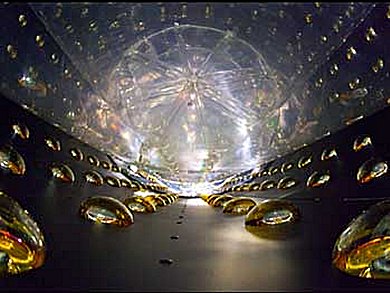The last of three measurements that describe how the three types, or flavors, of neutrinos blend with one another, providing a key to understanding how neutrinos change from one flavor to another, a phenomenon called neutrino oscillation have been reported. The results come from the Daya Bay Reactor Antineutrino Experiment in Guangdong Province, China, near Hong Kong, which is a joint collaboration between scientists in the United States, China, the Czech Republic, Hong Kong, Russia and Taiwan.
Neutrinos interact so weakly with other types of matter that they can pass through Earth as if it were not there. Once thought to be fairly boring, with zero mass and always traveling at the speed of light, neutrinos have proved to be a major challenge to the Standard Model of particle physics. Experiments showed that they do have mass and change their identity as they oscillate between three flavors: electron, muon and tau.
Each flavor of neutrino is a mixture of three different masses that fluctuate with time. Just as a white light composed of red, green and blue shifts its tint as the proportions of each color change.
Three numbers, called mixing angles, are part of the equations that describe the oscillations. The largest two were measured earlier in similar experiments with detectors set hundreds of kilometers from the neutrino source. The oscillation period associated with the third mixing angle was expected to be so small that a much shorter baseline experiment was needed.
The six power reactors at Daya Bay and nearby Ling Ao yield millions of quadrillions of electron antineutrinos every second, of which the six detectors recorded tens of thousands between Dec. 24, 2011, and Feb. 17, 2012. The detectors contain a liquid scintillator loaded with gadolinium. When the electron antineutrinos interact in the liquid, a blue glow is emitted.
Because some of the antineutrinos emitted by the reactors change flavor as they travel, the flux of electron antineutrinos measured in the detectors 1.7 km from the reactor is with 10,416 less than the flux of 80,376 coming directly from the reactor and measured in the nearby detectors that are about 500 m away. The deficit allowed scientists to determine the value of the so-called mixing angle theta one-three, or θ13.
A surprisingly large, non-zero value for the neutrino mixing angle with a significance of 5.2 standard deviations was measured.
The result allows comparing neutrino and antineutrino oscillations in the future and makes new experiments possible that may help explain why the present universe is filled mostly with matter, and not equal parts of matter and antimatter that would have annihilated each other to leave behind nothing but energy. One theory is that a process shortly after the birth of the universe led to the asymmetry, but a necessary condition for this is the violation of charge-parity (CP) symmetry. If neutrinos and their antimatter equivalent, antineutrinos, oscillate differently, this could provide the explanation.
Daya Bay will complete the installation of the remaining two detectors this summer to obtain more data about neutrino oscillations. As a result, Daya Bay will continue to have an interaction rate higher than three competing experiments in France, South Korea and Japan, making it “the leading θ13 experiment in the world”.
Image: The inside of a cylindrical antineutrino detector before being filled with clear liquid scintillator, which reveals antineutrino interactions by
the very faint flashes of light they emit. Sensitive photomultiplier tubes line the detector walls, ready to amplify and record the telltale flashes.
© Roy Kaltschmidt, LBNL
- Paper submitted to Physical Review Letters (PDF)




